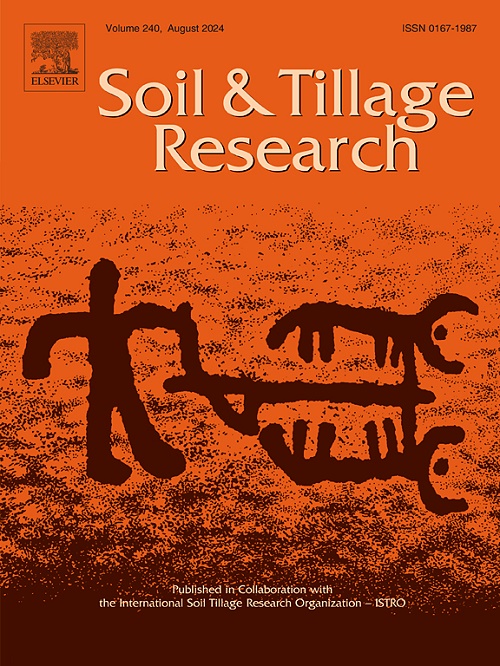传统除草与机器人除草对表土物理属性影响的比较评价
IF 6.1
1区 农林科学
Q1 SOIL SCIENCE
引用次数: 0
摘要
可持续的有机农业不仅要保持健康的植物,还要保持健康的土壤。不同强度的除草方法对土壤物理属性的影响不同,而土壤物理属性对有机作物的生长至关重要。本研究的目的是评估常规(CMM)和机器人(AAR)除草方法对有机甜菜生产中土壤物理属性的短期影响。通过为期3年(2021-2023)的试验研究,确定了两种不同杂草防治技术对土壤抗渗透、含水量、容重和孔隙度(总含水量和通气性)的影响。结果表明,CMM对土壤的压实作用大于AAR。在0 ~ 10 cm层中,穿透阻力增加了3.5倍,在10 ~ 20 cm层中,穿透阻力增加了2.6倍。这导致土壤孔隙度和通气性降低,而土壤孔隙度和通气性对植物根系发育和水分渗透至关重要。此外,AAR方法的土壤湿度水平更加稳定。这些结果突出了机器人杂草控制技术在有机农业系统中可持续土壤管理的潜力。通过减少土壤压实和保持良好的土壤物理特性,AAR杂草控制方法可以帮助实现可持续农业目标。本文章由计算机程序翻译,如有差异,请以英文原文为准。
Comparative evaluation of the effect of conventional and robotic mechanical weeding on topsoil physical attributes
Sustainable organic agriculture is based on maintaining not only healthy plants, but also healthy soil. Weed control methods with different intensities have different effects on soil physical attributes that are important for organic crop growth. The aim of this work was to evaluate the short-term effects of conventional (CMM) and robotic (AAR) weed control methods on soil physical attributes in organic sugar beet production. An experimental study was carried out for three years (2021–2023) to determine the effects of two different weed control technologies on soil penetration resistance, moisture content, bulk density and porosity (total and aeration). The results showed that the CMM increased soil compaction by a greater amount than the AAR. The penetration resistance increased by up to 3.5 times in the 0–10 cm layer and by up to 2.6 times in the 10–20 cm layer. This resulted in a decrease in soil porosity and aeration, which are essential for plant root development and water infiltration. In addition, soil moisture levels remained more stable with the AAR method. These results highlight the potential of robotic weed control technologies for sustainable soil management in organic farming systems. By reducing soil compaction and preserving favourable soil physical properties, the AAR weed control method can help achieve sustainable agriculture goals.
求助全文
通过发布文献求助,成功后即可免费获取论文全文。
去求助
来源期刊

Soil & Tillage Research
农林科学-土壤科学
CiteScore
13.00
自引率
6.20%
发文量
266
审稿时长
5 months
期刊介绍:
Soil & Tillage Research examines the physical, chemical and biological changes in the soil caused by tillage and field traffic. Manuscripts will be considered on aspects of soil science, physics, technology, mechanization and applied engineering for a sustainable balance among productivity, environmental quality and profitability. The following are examples of suitable topics within the scope of the journal of Soil and Tillage Research:
The agricultural and biosystems engineering associated with tillage (including no-tillage, reduced-tillage and direct drilling), irrigation and drainage, crops and crop rotations, fertilization, rehabilitation of mine spoils and processes used to modify soils. Soil change effects on establishment and yield of crops, growth of plants and roots, structure and erosion of soil, cycling of carbon and nutrients, greenhouse gas emissions, leaching, runoff and other processes that affect environmental quality. Characterization or modeling of tillage and field traffic responses, soil, climate, or topographic effects, soil deformation processes, tillage tools, traction devices, energy requirements, economics, surface and subsurface water quality effects, tillage effects on weed, pest and disease control, and their interactions.
 求助内容:
求助内容: 应助结果提醒方式:
应助结果提醒方式:


